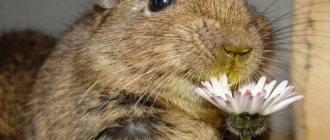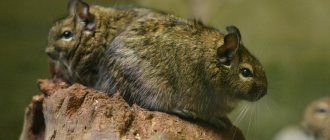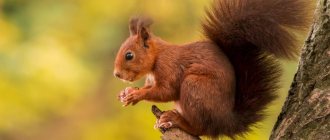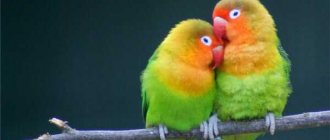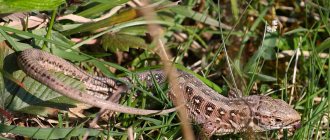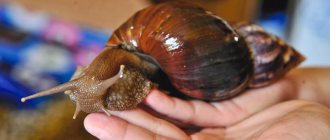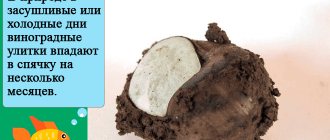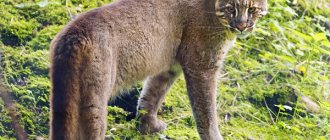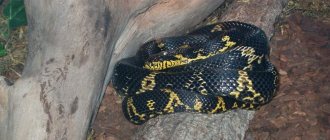Review author: “ZooVita”
Degu, which has a second name - bush squirrel, is a rodent that is widespread in Bolivia, Peru, Chile and Argentina. Living in natural conditions, the squirrel prefers rocky surfaces overgrown with vegetation.
At the moment, thanks to the funny appearance, which can be seen in the photo of the Degu squirrel, activity and friendliness, they began to keep it as a pet. Domestic Degus very easily get used to people and take root in their homes.
Exterior and internal structure features
The Chilean Degu squirrel has two coat colors: gray-brown and yellow-brown. The fur is very soft and short. The color of the back is gray-brown, with a possible orange tint. The belly color is creamy yellow. The paws are gray, and the end of the tail may be white. They have the characteristic feature of shedding the skin from their tail in case of danger. Subsequently, the squirrel chews off the exposed part of the tail.
There are options for artificially obtained colors of the Degu squirrel: spotted, sand, lilac, black, white and blue.
The physique of the rodent is similar in both color options. The length of the squirrel reaches 22 centimeters. The length of the tail varies within nine centimeters. Degus weigh no more than three hundred grams. The ears are quite long, with pointed tips.
Slightly convex eyes have vertical pupils. The diameter of large and round eyes with black pupils can reach eight millimeters. The eyes of the Degu squirrel, located opposite, provide it with a view of almost 360 degrees.
Gray-brown, large squirrel ears are oval in shape. When there is complete silence, they are pressed against the head, but when sounds appear, they rise vertically. The rodent's ultra-sensitive hearing system gives it the ability to distinguish sounds that are inaccessible to human hearing.
The squirrel's nose is covered along the edges with abundant antennae, which serve as a sense of smell.
The Degu squirrel has 20 orange teeth. Of these, there are four incisors, located in pairs on the upper and lower jaws, using which rodents can gnaw through fairly durable materials.
Degu's paws are covered with gray hairs and have black claws. The squirrel's front legs are short.
The tail ends in a tassel and is covered with rough, short bristles.
How many individuals are best kept together?
Degus prefer company. If the owner can pay enough attention to his pet, then the option of solitary housing is quite acceptable. The gender of the animal is not particularly important, but it should be noted that males are more sociable and easier to tame.
No special knowledge is required about how the sex of a degu is determined. It is enough to estimate the distance between the anus and the urethra. In females it is much smaller than in males.
It is acceptable to keep them in pairs, preferably of the same gender and age. In this case, the animals will definitely not be bored. For breeding, you should create a small group of one male and several females. It should be borne in mind that it is permissible to form a pack with age restrictions, since after 4 months of age the animals are reluctant to accept new ones and can seriously conflict.
Important! Family ties should be taken into account. Keeping one litter with the prospect of mating is unacceptable, as this leads to weakened immunity in the new generation and degeneration of the breed.
Habitat territories
Degu squirrels living in burrows have chosen South America as their habitat. They prefer desert or rocky areas, but can live in swampy and wooded areas. They can also settle in floodplains.
Getting used to the cage
After acquiring a rodent, there is a natural desire to place it in a cage as soon as possible. It is not recommended to do this, since the animal needs some time to adapt to the surrounding reality. It is best to place the box in which the Chilean squirrel was transported next to the cage. Over time, when the animal gets used to the new environment and begins to behave more calmly, you can remove it from the carrier and place it in a cage.
It should be remembered that this must be done carefully so as not to cause unnecessary anxiety in the animal. Before this, it is recommended to place part of the bedding from the carrier in the place designated for the squirrel’s permanent residence. The degu will smell itself in the new place, which will help it cope with anxiety.
After the animal gets comfortable, it is necessary to walk it periodically. It should be allowed into a previously fenced off part of the room, freed from electrical wires, glassware and other objects that may attract the attention of degu squirrels. Some indoor plants can also pose a danger to these animals - anthurium, calla lilies, ivy, rhododendron, sansevieria, etc.
After a walk, the animal may not want to go back to the cage. In this case, you should place the structure next to it and open the door. The animal will soon come inside because it is either hungry or thirsty.
You can speed up this process by giving treats accompanied by soft whistling. The degu will remember this sound and will subsequently respond to it by running up to the feeder. If you have to catch the animal, you should under no circumstances cover it with your palm, otherwise the squirrel will be stressed. Do not grab the squirrel's tail to avoid damaging it.
Nuances of nutrition
The “menu” of the Degu squirrel consists of: all kinds of herbs, including medicinal ones; roots, leaves and flowers of shrubs; plants' seeds; vegetables and tree bark.
Since the squirrel is a herbivore, its diet should contain plant food daily, including hay, leaves and grass. Plant food is necessary for rodents to fully develop.
Hygiene procedures
Degus, being very clean animals, clean and degrease their fur on their own using the dry cleaning . Bathing procedures are ensured by placing a deep tray or bath with special sand in the cage every day for bathing.
To avoid the occurrence of an unpleasant odor, it is necessary to remove any leftover food every day and periodically change the bedding in areas of contamination. A complete replacement should not be carried out, since rodents are very sensitive to changes in the environment. The bedding's own scent, which permeates the litter over time, calms the animals.
We advise you to read about the features of keeping and breeds of decorative rabbits.
Reproduction
The mating season of the bush squirrel continues from late winter to mid-autumn. During one year, a rodent can produce offspring a maximum of two times. For squirrels living in captivity, the mating season is not tied to the seasons.
A female Degu can become pregnant again immediately after giving birth, but this can lead to the death of the squirrel or its offspring. Gestation of baby squirrels occurs over a period of three months.
Feeding with mother's milk, on average, 6 babies born, occurs over the course of four weeks. Parents also feed the squirrels with fresh vegetation.
Purchase
It's time to go find a new tenant. What do you need to know so as not to make a mistake in your choice?
Where can I buy
To the question: “Where can I buy a degu?”, the correct answer is: “Of course, in a pet store or from breeders!” There you can get comprehensive advice on growing, care and maintenance, and they will help you with choosing food and a cage for your pet.
Buying on the street or in the market is dangerous, because you won’t know for sure whether it is degu at all. And it’s easy to buy a sick animal, which in two days will die for some unknown reason. For the same reasons, you should not handle degus.
How to choose
You should choose a degu according to the following criteria:
- age is at least one and a half months, because until this time they still feed on mother’s milk
- living conditions for parents and children: clean cage, dry bedding, access to water and food
- nutrition, because if parents do not eat properly, then they may not have the healthiest offspring
- appearance - clean shiny fur, clear eyes, skin and ears are not red and without sores
- behavior, because degus are active animals, so degu squirrels should be active and not shy
- if the age is more than two months, then males should live separately from females
Degus reach sexual maturity early, so be careful not to buy a pregnant female. In general, experts advise keeping same-sex couples to avoid unplanned offspring.
Female degus give birth to a small number of children, but almost immediately the birth field is ready for mating again, and frequent pregnancies significantly undermine her health. Therefore, they are kept separately from the males so that the female can recover and calmly feed the offspring.
How many individuals is best to keep?
These little squirrels are gregarious, so it's best to keep a couple of them. If you have no plans for further breeding, then feel free to purchase two animals of the same sex and from the same flock at once. It will be easier and more fun for them together, and they will quickly adapt to life in a new home.
How to determine gender
If you know how this is done, then it is not difficult to determine the sex of a degu, especially if it is already a grown animal.
Raise the squirrel's tail. Below it you can immediately see the anus, but lower down you can see a protruding process. This is the urethra. It looks the same in both sexes.
And by the distance between it and the anus they determine what gender the individual is in front of you: the male will have it the size of a human little finger, but the female will have almost none.
Price
The price of a degu starts from three hundred rubles for one degu squirrel, but only the breeder himself will tell you how much a pair costs. But you need to take into account that you will also have to spend money on a cage, food, toys and bedding. So the total cost will be in the region of seven to ten thousand rubles.
Character traits
Degu squirrels are very sociable burrowing animals. They dig their burrows together, creating large networks of tunnels. Despite their developed homes, rodents spend a lot of time searching for food on the surface. One group of squirrels can develop an area of 200 m2.
Communication between individuals occurs using fifteen sounds that a rodent can make, as well as using tactile, acoustic and chemical means of perception.
The period of activity is the daytime, mostly morning and evening. A group of squirrels, with a fairly developed hierarchical system, has its own territory, which they defend from the invasions of strangers.
How long Degus live depends on the territory and living conditions. In natural conditions, they extremely rarely live up to two years, but when kept at home they can live up to ten years.
What to name the animal
Funny names with the suffix -ik work well for degus
When choosing a name for a pet, owners usually pay attention to the external features of the animal and its characteristic behavioral habits. This is where popular nicknames like “Shustrik”, “Ryzhik”, etc. come from.
Owners often draw names for their pets from movies or books, calling their charges “Bonnie and Clyde” (popular for a couple of Degus), “Rick and Morty”, etc.
Scientists have found that all rodents are better suited to nicknames that begin with the letters Z, C or S. It is these sounds that Degus perceive best, which means your pets will respond to their name faster.
Home content
Anyone who is thinking about getting a Degu squirrel as a pet needs to analyze all the positive and negative aspects of this animal. The conditions for keeping Degus, like any pet, have their own nuances.
The positive aspects include:
- Extremely curious and active, Degus become very attached to their owner;
- They do not have unpleasant odors and do not require excessive hygienic care;
- Quite simple maintenance of the cage, since the squirrel does not produce a large amount of secretions;
- The miniature size of the animal will not require a large cage;
- The period of activity occurs during the daytime, and therefore does not disturb the owner at night with unnecessary noise;
- Very modest amount of food consumed;
There are also some disadvantages to keeping Degu squirrels at home:
- Squirrels are rodents and when walking around a person’s home they can damage wiring, furniture and shoes;
- Degus are prone to destruction and destroy the entire contents of the cell, which requires constant replacement;
- The tendency for squirrels to take sand baths is a very weedy habit;
- Some difficulties in taming.
In order for the Degu squirrel, existing at home, to have good health and live as long as possible, it is necessary to take a responsible approach to its diet and living conditions. And while keeping a rodent does not require much effort, the animal is extremely picky when it comes to nutrition.
Squirrels require a strict diet because their body cannot regulate blood sugar levels. The diet should contain a large amount of plant foods, fruits and vegetables.
It is possible to use special ready-made food as food. It is advisable to feed the squirrel five times a day in small doses. Any fermented milk products are contraindicated for degus.
So that the rodent lives happily ever after
Remember: degus are very susceptible to stress, which has a bad effect on its health and life expectancy. Try to minimize stressful situations. They can occur when communicating with the owner, children, other animals, when going to the veterinarian, or changing the diet.
To minimize stress for the animal:
- teach children how to properly handle a pet;
- do not raise your voice at him;
- replace the diet gradually;
- do not allow pets near your pet;
- After going to the vet, give the animal a treat and leave it alone for a while.
The main thing is to love your pet. This is the key to his long and happy life.
